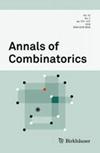论$$\mathbb {R}^d$$ 中的邻简数目
IF 0.7
4区 数学
Q4 MATHEMATICS, APPLIED
引用次数: 0
摘要
如果在 \(\mathbb {R}^d\) 中的两个 d 维单纯形的交集是一个 \((d-1)\)维集,那么这两个 d 维单纯形就是邻集。如果 \(\mathbb {R}^d\)中的每两个简单集都是相邻的,那么这个 d 维简单集群就叫做相邻简单集群。设 \(S_d\) 是 \(\mathbb {R}^d\) 中 d 维简约邻域族的最大卡片数。基于一些代码的结构(V/subset \{0,1,*\}^n\),可以证明(\lim _{d\rightarrow \infty }(2^{d+1}-S_d)=\infty \)。此外,还给出了一个关于编码结构的结果(V子集{0,1,*\}^n\)。本文章由计算机程序翻译,如有差异,请以英文原文为准。

On the Number of Neighborly Simplices in \(\mathbb {R}^d\)
Two d-dimensional simplices in \(\mathbb {R}^d\) are neighborly if its intersection is a \((d-1)\)-dimensional set. A family of d-dimensional simplices in \(\mathbb {R}^d\) is called neighborly if every two simplices of the family are neighborly. Let \(S_d\) be the maximal cardinality of a neighborly family of d-dimensional simplices in \(\mathbb {R}^d\). Based on the structure of some codes \(V\subset \{0,1,*\}^n\) it is shown that \(\lim _{d\rightarrow \infty }(2^{d+1}-S_d)=\infty \). Moreover, a result on the structure of codes \(V\subset \{0,1,*\}^n\) is given.
求助全文
通过发布文献求助,成功后即可免费获取论文全文。
去求助
来源期刊

Annals of Combinatorics
数学-应用数学
CiteScore
1.00
自引率
0.00%
发文量
56
审稿时长
>12 weeks
期刊介绍:
Annals of Combinatorics publishes outstanding contributions to combinatorics with a particular focus on algebraic and analytic combinatorics, as well as the areas of graph and matroid theory. Special regard will be given to new developments and topics of current interest to the community represented by our editorial board.
The scope of Annals of Combinatorics is covered by the following three tracks:
Algebraic Combinatorics:
Enumerative combinatorics, symmetric functions, Schubert calculus / Combinatorial Hopf algebras, cluster algebras, Lie algebras, root systems, Coxeter groups / Discrete geometry, tropical geometry / Discrete dynamical systems / Posets and lattices
Analytic and Algorithmic Combinatorics:
Asymptotic analysis of counting sequences / Bijective combinatorics / Univariate and multivariable singularity analysis / Combinatorics and differential equations / Resolution of hard combinatorial problems by making essential use of computers / Advanced methods for evaluating counting sequences or combinatorial constants / Complexity and decidability aspects of combinatorial sequences / Combinatorial aspects of the analysis of algorithms
Graphs and Matroids:
Structural graph theory, graph minors, graph sparsity, decompositions and colorings / Planar graphs and topological graph theory, geometric representations of graphs / Directed graphs, posets / Metric graph theory / Spectral and algebraic graph theory / Random graphs, extremal graph theory / Matroids, oriented matroids, matroid minors / Algorithmic approaches
 求助内容:
求助内容: 应助结果提醒方式:
应助结果提醒方式:


